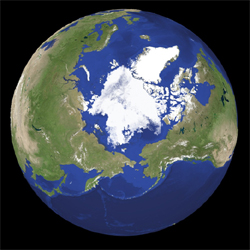2010.08.19
GIC Weekly Report Vol.3
A high pressure, promoting sea ice decline for the Northwestern Passage.
Topic of the Week
The Arctic sea ice has continued to decrease throughout this week. Pronounced declines in ice extent have been observed across coastal areas of the Canadian Arctic Archipelago in the western Arctic. Within the region, sea ice are broadly melting out in the northern part, and remarkable melting is seen over several areas in the southern part, particularly in Larsen Sound and M'Clintock Channel.
A high-pressure system dominating over the Canadian islands in the past few days allows us to see a clear view of the area in satellite imagery. Figure 1 shows a close-up of the area derived from NASA Terra/MODIS data. As seen in the figure, the Northwestern Passage is still hindered by several icy areas (indicated in red curve). However, considering the current low ice extent and the trend of rapid ice melting seen in recent weeks, the chance for the opening is still high. As the dominating high is forecasted to persist for a few days, the trend of ice melting is expected to continue and, consequently, promote the opening of the passage.
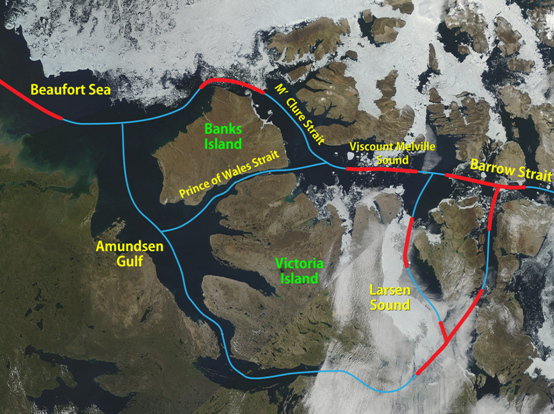
Figure 1. Satellite image over the Western Arctic Canada (Terra/MODIS, 2010-08-17). Blue lines show ice-free routes of North Western Passage. Red lines show ice-covered routes of the Passage.
Sea Ice Extent
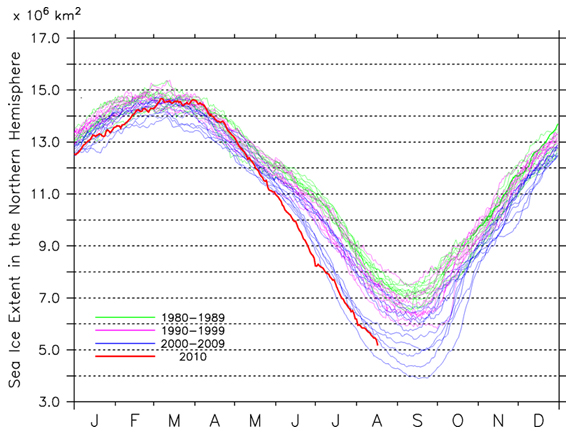
|
Arctic Western Arctic Eastern Arctic |
Figure 2a-2c. Sea ice extent of the entire Arctic(2a), western Arctic(2b), and eastern Arctic(2c)
Figure 2a depicts changes in the Arctic sea ice extent during summer season. The current sea ice extent in the entire Arctic is estimated to be about 5.2 million square kilometers. As seen in the previous period, this is still following the second lowest level for this time of year after the extent of about 4.7 million square kilometers in 2007, the year of the record low minimum extent. Our analysis suggests that sea ice of approximately 5 million square kilometers has melted away over the last week, and the sea ice extent will continue to decrease in late August.
A remarkable sea ice retreat has been seen in the western Arctic (shown in Figure 2b). On the other hand, somewhat moderate decline of the extent has been observed in the eastern Arctic (shown in Figure 2c). Thanks to this trend of rapid ice melting in the western area, the decline slope in the Arctic as a whole is still steep.
Figure 3 illustrates the current sea ice distribution in the entire Arctic derived from passive microwave satellite data. A noticeable change in sea ice conditions from the previous period is the ice concentration in the Beaufort Sea which appears to become substantially thinner during this week. In addition, sea ice extent in the East Siberian Sea has shown a clear retreat compared to that of last week.
Sea Ice Conditions along Polar Routes
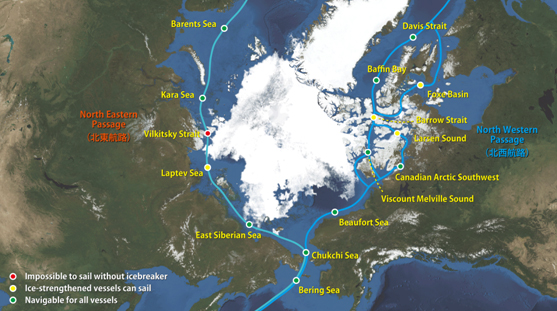
Figure 4. Sea ice condition around the North Eastern and North Western passages.
Figure 4 depicts the current conditions of the polar routes on top of satellite imagery. Continuing from last week, neither of the eastern and western polar routes has been yet fully open. Some degree of sea ice distributions observed in several coastal areas such as north of the Banks Island, the Viscount Melville Sound, Barrow Strait are still blocking the main route of the Northwestern Passage. There are some good signs, though. In addition to the continuous ice melting observed in the main path from the Beaufort Sea to Baffin Bay via the M'Clure Strait and Viscount Melville Sound, sea ice coverages along southern routes of the area have shown remarkable declines over the last week.
A substantial portion of sea ice in the Larsen Sound, for example, has drifted westwards over the last week, resulting in a decrease of the ice concentration from 1/10 to 3/10. Some sea ice remaining in several regions, such as an area between Victoria Island and King Williams Island, and coastal area of M'Clintock Channel, will be of particular interest. If the trend of ice melting continues in this area throughout the rest of August and early September, those southern routes are highly likely to open, encouraging the Northwestern Passage to open sometime this summer.
In the eastern Arctic region, sea ice are still distributed broadly in the East Siberian Sea and the Laptev Sea. The Northeastern Passage, therefore, is forecast to stay closed.
Model Prediction
Figure 5 indicates the forecast of the Arctic sea ice distribution in 19 August to 3 September based on Weathernews' I-SEE engine, suggesting a continuous decrease of the Arctic sea ice extent for a while.
A clockwise atmospheric flow associated with the dominating high pressure over the Beaufort Sea is expected to continue pushing sea ice northwards, meaning that some of the scattered sea ice currently blocking the Northwestern Passage will be cleared off.
By contrast, somewhat thick sea ice distribution over the Laptev Sea is forecast to persist throughout the period, thus there is less chance for the Northeastern Passage to open for a while.
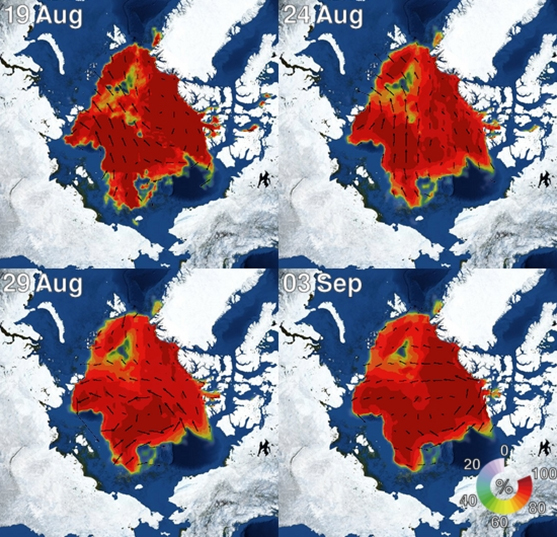
Figure 5. I-SEE engine model predictions of Arctic sea ice.


